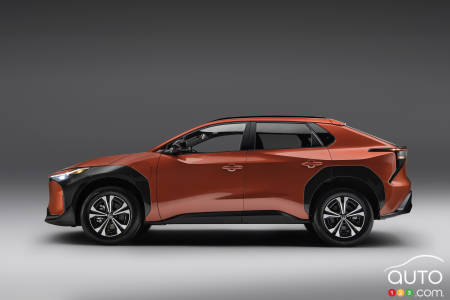
Auto123 gets in a first drive of the 2023 Toyota bZ4X, the first all-electric model from the Japanese brand.
Encinitas, CA - Two weeks ago, we found our way to California to get behind the wheel of Toyota's first electric model, the bZ4X SUV.
The eagerly awaited bZ4X marks the Japanese auto giant's first step towards full-on electrification, and it's sure to spark some discussion. Indeed, how to explain the company lagging behind several rivals in entering the all-electric waters, when the company had shown the way to everyone else in terms of hybridity?
And why start with a model that doesn't stand out as offering more power, more range and better charging capabilities than those rivals?
On the other hand, some of the aspects of the new bZ4X are right on the money, and I’d go so far as to say that about the model in general.
Browse cars for sale available near you
Partnership
The bZ4X is the result of a partnership with Subaru, the second major collaborative effort between the companies in fact. Out of this partnership will also come, very soon, the Subaru Solterra. The resemblance between the two is strong, although the signature remains unique to each brand. What's important to us in this instance, as we discover the bZ4X, is what Subaru brings to the Toyota EV, including the X-Mode all-wheel drive system with different driving settings.
Proportions
Many of you have asked us where the bZ4X fits in to the Toyota lineup in terms of size. To put it simply, it's a little longer than the RAV4 (94 mm), which means it's more spacious. This is quite obvious when you get inside, especially since the wheelbase is larger (160 mm). The model is less tall (50 mm), however, which can be confusing at first glance. Lastly, it’s also wider than the RAV4, but by a hair (5 mm).
In general terms, we're talking about the same category, that of the compact SUV.
The hardware
Similarities aside, the two models are diametrically opposed when it comes to what propels them. The bZ4X is equipped with a 71.4-kWh battery in the case of the front-wheel-drive version, and a 72.8-kWh pack in the case of the all-wheel-drive variants. Yes, two almost identical battery sizes – and that is a well-kept secret for now by Toyota. The powertrain configurations deliver 201 and 216 hp, respectively.
Torque is the same at 196 lb-ft (a maximum of 124 per axle for the 4-wheel-drive version). That's not anything to write home about, but since it's delivered at the touch of the throttle, you'll be fine the quick starts – although the more you do that, the higher the energy consumption, it should be remembered. Passing manoeuvres are also stress-free, but they are less impressive at higher speeds.
As for rest of the driving experience, well, let’s say it's... uneventful. Fortunately or unfortunately, depending on your allegiances or preferences, driving an electric vehicle delivers little or no sensation. The bZ4X falls more into the latter category. In fact, if you’re forced to come up with any discernable “qualities” to stick on the model, you’d have to focus on stuff like the silence that reigns on board, or the overall comfort.
And given the current price of gas, I suppose another quality of the bZ4X is that it allows you to snicker a little every time you pass a gas station.
Range
A lot of information about the bZ4X was shared before its launch, but the most interesting ones were kept secret. For example, the range of the different versions. These have now been announced at 406 km and 367 km, depending on the model configuration (two- or four-wheel drive).
Obviously, our first contact was too short to give you any kind of range assessment, especially over the long term, but the good news is that the models we tried out “promised” (showed as estimated range on the onboard computer) more than what Toyota is promising. A front-wheel drive version, for example, suggested 284 miles, the equivalent of 457 km. Of course, the weather was ideal, and not always what we can expect in Canada. Our cold weather being EV range killers has been widely reported and well-documented.
The versions
There are four models in the product offering, although officially there are three variants. First, the L and LE models, both with front-wheel drive, and priced at $44,990 and $49,990, respectively. This is no surprise at all, as the federal government and several provinces restrict their EV incentives to models with base prices below $45,000.
The other two models are the XLE and XLE with Technology Package. Here, Toyota gets creative with a little sleight of hand. The first will sell for $54,990, the second for $62,790. But to obtain the Quebec provincial subsidy, the barrier is $60,000. By offering an option package with the XLE model, Toyota limbos beneath the bar. If that more-equipped variant had been called something else (Limited, for example), it would not qualify. There is a loophole in the system and the manufacturers are exploiting it.
Note that in regards to the federal iZEV incentive, if the base price is under $45,000, other variants qualify as long as they are under $55,000. That explains the price range.
As for the equipment included with each variant, it’s pretty comprehensive right from the LE model. That said, that base model comes without heated seats and steering wheel, and with an 8-inch screen instead of a 12.3-inch one for the multimedia system. It also lacks, as does the other front-wheel drive model, wireless charging for cellular devices.
There are, however, some interesting features related to energy efficiency, such as a heat pump for climate control and radiant heating for the front footwell.
Recharging
As far as energy recovery is concerned, here's what the company has announced. An integrated charger offering a capacity of 6.6-kW will allow a complete recharge in 11 hours on a Level 2 terminal. With an ultra-fast charger, the maximum capacity is 150-kW for front-wheel-drive models and 100-kW for all-wheel-drive models.
As you can guess, Toyota was questioned about the “lacklustre” capacities in play here, and the answer was a typically Toyota one. The company says it prefers to go conservative in order to ensure that the system will work well in the long term and be reliable. True to form, Toyota is playing it safe. And to be fair, that’s a strategy that has worked well for it over the years, despite a few missteps.
Toyota is evidently making the calculation that some other manufacturers might be being too aggressive.
On board
The interior is a mitigated success in my opinion, but much of that comes down to taste; we'll let you be the judge. On one point, however, I insist: the layout of the instrumentation is a disaster. Take a look at our pictures and you'll understand. The information screen is hidden by the steering wheel. If you're over six feet tall or like an elevated driving position, you'll be fine. Otherwise, you won't see anything. It’s hard to understand how this design flaw persisted through to the final product.
Also, it's time Toyota maybe provided us with the cargo volume behind the first row. We only have the data behind the second row, which is 784 litres, and it would be useful to know the volume with the rear seats folded down. I should note that we encountered the same problem with the Corolla Cross.
Specifications sheet of 2023 Toyota bZ4X L FWD
Specifications sheet of 2023 Toyota bZ4X LE FWD
Specifications sheet of 2023 Toyota bZ4X XLE AWD
The verdict
The bZ4X is going to be a success. Its pricing is in the right range, it enters a segment with exploding demand and it carries the Toyota logo - three elements that really argue in its favour. As for the company's lateness in debuting a first all-electric model, it's worth remembering that Toyota believes in a diversity of powertrains to serve its customers around the world. It doesn't see a single solution.
And so the bZ4X will go about its reliable business and do what it’s made to do - quietly, in every sense of the word.
As we’ve seen with many recent new EV models, the question of availability remains. Toyota Canada is announcing a commercial debut in the spring (as in, in the next few weeks, maybe next couple of months), but we know that quantities are not only limited, but also limited for our market. Good news for Quebec and British Columbia residents, you'll be served first. But we’d suggest you don’t dawdle about reserving a bZ4X if you’ve decided you want one. The wait could be long. Very long.
The competition
Ford Mustang Mach-E
Hyundai Ioniq 5
Kia EV6
Nissan Ariya (to come)
Subaru Solterra (to come)
Volkswagen ID.4
See also: Subaru Solterra and Toyota bZ4X: What We Know So Far About the Close Cousins








